Top News

February 4, 2014 Ryukyu Shimpo
The Jahana kippan-ten won the highest prize for its product tougazuke assortment at the 36th Naha food and product fair. It received the highest score among the products of 17 companies at the judging held on January 17. The judges recognized this sweet for creating a new concept of the traditional sweet and for the novelty of the package. Hisano Jahana, the president of the shop, was pleased with the award. “Honestly, I am happy because I am confident about this product,” she said.
Kippan and tougazuke originally came from China 300 years ago. They are traditional sweets, which were served to members of the royal government and Chinese envoys during the Ryukyu Kingdom era. With this luxury tougazuke assortment, you can enjoy five different tastes – plain, toasted soybean flour filled with black bean produced in Tanpa, Kyoto, green powdered tea, ginger-brown sugar and coconut.
Jahana became the sixth-generation owner three years ago. “I want young people to enjoy the taste of the Ryukyu traditional confectionery,” she said. Jahana gained an idea for the tougazuke assortment seeing her husband, who is from England, sprinkling powdered green tea on the sweets. After some trial and error, she completed the tougazuke assortment. This sweet was praised in well-established tea rooms in Kyoto. Chocolate tougazuke will be sold in the shop until the end of March. The 36th Naha Food and Product Fair will be held at the Ryubo Department Store in Naha from February 18 to 24.
(English translation by T&CT)
Go to Japanese
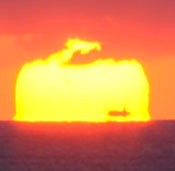
January 29, 2014 Ryukyu Shimpo
Ryoichi Komiya, a member of the Friends of Nago Museum, successfully filmed a mirage in which light rays produce an image of a distant object. A mirage was observed on January 6. An image of a big ship cut across in front of the setting sun at the Nago Bay. Komiya, who films sunsets as his hobby, happily said, “It occurs once in a thousand or ten thousand chances.”
He took the image at around 6 p.m. on the 6th. Komiya used magnifying power 30 to film it with a portable camera from the top of a five-floor building. Joining Komiya, Koichi Tsuchihashi, who is also a member of the museum, realized that it was a mirage.
Taking about three minutes, a ship cut across in front of the sun, which looked square because of the mirage. The museum said it was rare to record such an image. Air becomes dense when it gets cold and lights bend toward the denser direction. Light rays, which reflect an object at the other side of the horizon, usually move towards the sky. When there is a temperature gap between sea surface and midair, light rays bend to the sea surface with low temperature and high-density, which creates a mirage.
(English translation by T&CT and Megumi Chibana)
Go to Japanese
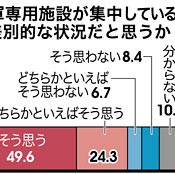
January 29, 2014 Ryukyu Shimpo
The Okinawa Prefectural government carried out an awareness survey for Okinawan people from October to November 2012. The survey revealed on January 28 that 73.9 percent people see the situation in which about 74 percent of the U.S. military facilities in Japan is focussed on Okinawa as discriminatory.
Asked whether the Japanese government operates acceptable policies for the base issues, about half of the surveyed felt dissatisfied.
The prefectural government carried out the survey to know how Okinawan people’s consciousness and values changed. They used to carry out the survey every five years from 1979 to 2009. The government surveyed seven times in total. They will change to carry out every three years.
The government carried out the survey at the end of the administration led by the Democratic Party of Japan. Adding analysis to the survey results, they plan to announce it before this March.
Asked whether about 74 percent of the U.S. military facilities in Japan being concentrated in Okinawa is discriminatory, 49.6 percent of those surveyed said, “I think so.” The survey saw 24.3 percent saying, “I somewhat think so.” The people who said, “I don’t somewhat think so” accounted for 6.7 percent and those who said, “I don’t think so” for 8.4 percent.
Asked whether the Japanese government has acceptable policies for the issues caused by the bases, about 27 percent of those surveyed said, “The policies are not satisfying at all.” Those who said, “The policies are relatively not satisfying” accounted for 22.4 percent of the surveyed. Those who said, “I can’t answer” accounted for 22.3 percent and those who said, “The policies are rather satisfying” for 6.1 percent of the surveyed. The people who said, “The policies are very satisfying” accounted for 3.0 percent of the surveyed.
The government asked the people to rank the policies that the government should stress to work on, and choose the top three. Promoting employment and career skills went to the top, supported by 16.8 percent of the surveyed. Secondly, creating attractive tourism and resort spots came to the second place supported by 15.4 percent. Those who favored downsizing the bases, developing the land returned by the U.S. military and promoting the resolution of base issues such as revising the Japan-U.S. Status-of-Forces Agreement, accounted for 12.2 percent.
The prefectural government carried out the survey targeting 2,000 people ranging from 15 years to 75 years of age in 200 areas in the prefecture from October 6 to November 5, 2012. They had 1,612 respondents.
The survey response rate was 80.6 percent.
(English translation by T&CT)
Go to Japanese
January 31, 2014 Ryota Shimabukuro of Ryukyu Shimpo reports from Washington D.C.
Susumu Matayoshi, the head of the Executive Office of the Governor, met Marc Knapper, director of the Office of Japanese Affairs and Andrew Winternitz, the Pentagon director for Japan policies at the Department of Defense on January 30.
Matayoshi explained to them about the four policies to reduce Okinawa’s burden of bases that the prefectural government had asked the Japanese government to carry out.
According to Matayoshi, the U.S. side stressed the current plan of closing the base after building new one, for which construction will take nine and a half years. They did not specifically mention the policies that the prefectural government had requested. The U.S. side told Matayoshi that they appreciated Okinawa governor’s approval of the Henoko landfill.
Nakaima asked the Japanese government to carry out four policies to reduce Okinawa’s burden of bases with his approval of the landfill at the end of 2013.
Nakaima was optimistic about stopping operations at Futenma within five years, saying, “The Prime Minister said he will work on it.” However, the U.S. side once again did not mention it.
(English translation by T&CT)
Go to Japanese
Generic Cialis, your body is a PDE5 inhibitor which function by restoring a healthy balance of chemicals in the system that are required to respond in a robust way to stimulation. Its active ingredient is called tadalafil – it helps to relax the smooth muscle lining the blood vessels to the more blood you can to enter the body of your arm your finger, and therefore, it is swollen, you will then get the hard. Most men suffering from ED.
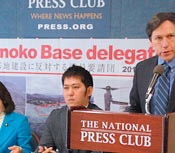
January 31, 2014 Ryota Shimabukuro of Ryukyu Shimpo reports from Washington D.C.
On January 29, Keiko Itokazu, a member of the Upper House and a leader among the anti-U.S. base movement, and Naha City councilors held a news conference in Washington D.C. They spoke about their direct appeal to the American people and their political leaders. The members from Okinawa met Jim Webb, a former senator and Secretary of the Navy who, when in the U.S. Senate Armed Services Committee, led the review of the plan to relocate U.S. Futenma Air Station to Henoko. The former senator underscored that he did not agree with the Henoko plan. The governments of Japan and the United States insist that the plan is the only way to resolve the issue. He also said that if Okinawa Governor were to ask him for advice, he would offer to be a mediator for talks on the realignment plan among Okinawa and Guam, which are the interested parties, and the governments of the United States and Japan.
Itokazu and other members exchanged opinions with the officials of the United States Government, lawmakers and legislators, and researchers of think tanks. Many of the interviewees suggested that moving the Futenma base to Henoko was only way to avoid keeping the base as it is. However, the members from Okinawa asserted that the Okinawan people would not accept building a new base and that the governments of the United States and Japan should propose another option to resolve the issue. Peter Kuznick, a professor of history at American University and John Feffer, a representative of a think tank attended the news conference.
Kuznick is an initial signer of the statement by the international scholars and peace advocates opposing the construction of a new U.S. military base in Henoko. He said, “The New York Times noted that there were three players of the United States, Japan and Okinawa in this drama, the Futenma issue. I want to add a fourth player, the international community.” Feffer pointed out that U.S. Marine Corps Air Station Futenma could be closed without relocation, because the troops will be redistributed to Hawaii, Guam and Australia.
Itokozu commented, “We were worried about the mistaken message on the landfill approval by Okinawa Governor Hirokazu Nakaima. Anyway, we could tell the people in Washington D.C. about the re-election of Nago Mayor Susumu Inamine, who opposes building a new base.”
(English translation by T&CT)
Go to Japanese
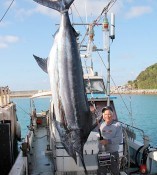
January 31, 2014 Yoko Morinaga, correspondent of Ryukyu Shimpo
On January 30, the day before the New Year of the old calendar, a big blue marlin or kurokawakajiki, 4 meters long and weighing 333 kilograms was caught on Kumejima Island. Captain Kunio Nakamichi, 63, a member of the Kumejima Fishery Cooperative, caught the big fish after a struggle of about two hours.
Nakamichi said with a big smile, “This is the first time that I have caught such a large marlin. I can celebrate a good New Year.”
Fishermen on the island caught a big catch, including seika or diamond squid and albacore tuna. This blue marlin was put up for auction at the fish market on the main island of Okinawa.
(English translation by T&CT)
Go to Japanese
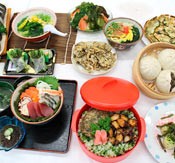
January 29, 2014 Ryukyu Shimpo
Onna Village is the birthplace of cultivating seaweeds such as sea grapes, mozuku and sea lettuces. In the village, the Seaweed Food Fair started on January 29. Twenty-three restaurants took part. The event continues until April 30.
According to the Village Commerce and Industry Association, it is the first time the Seaweed Food Fair has been held in Okinawa.
The previous day, at the Village Rapport Experience Learning Center, participating restaurants unveiled dishes that they will sell in the fair.
Many people see seaweed as sashimi garnish. However, the chefs creatively used it to provide 39 colorful dishes such as Mediterranean pasta, Italian pizza, bowls of rice topped with sashimi, and hamburgers.
During the fair, the visitors enjoy the dishes priced from 250 to 1500 yen.
The Village Fisheries Cooperative produces about 1,500 tons of mozuku, about 60 tons of sea lettuce and about 65 tons of sea grapes every year. The cooperative aims to increase demand for seaweed from Okinawa because many buyers of their products are outside of the prefecture.
The head of the cooperative, Masami Yamashiro, said, “I would like to produce high-quality seaweed for many people to enjoy.”
(English translation by T&CT)
Go to Japanese
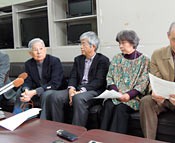
January 28, 2014 Ryukyu Shimpo
On January 27, 65 scholars and journalists in Okinawa and other prefectures issued an emergency statement asking the governments of Japan and the United States to abandon their plan to move U.S. Marine Corps Air Station Futenma from Ginowan to Henoko in Nago, and to close the base early. This statement was made in response to Susumu Inamine’s re-election as mayor of Nago. The signers stressed that the election result was an expression of dissent towards the new base not only by the citizens of Nago, but also by the Okinawan people. They requested that the governments respect the voice of the people of Okinawa.
Seigen Miyazato, a political scientist and adviser of the Okinawa International Issues Study Group, and other signers issued the statement at a news conference held on January 27. The signers included scholars who specialize in constitutional law and political science, and journalists. They sent the statement to President Barack Obama, Prime Minister Shinzo Abe and U.S. Ambassador to Japan, Caroline Kennedy.
Miyazato commented, “The planned facility in Henoko will be a permanent base. We cannot afford it. The people who live in Okinawa have the right to receive equal and fair treatment as citizens of the rest of Japan and the United States.”
One year ago the mayors of all 41 municipalities visited Prime Minister Abe to submit the petition to cancel the relocation plan within the prefecture. Kunitoshi Sakurai, a professor at Okinawa University, stressed, “We must rebuild an ‘All-Okinawa’ system. We have the common ground that we will decide the future of the region for ourselves.” Masaaki Gabe, a professor at the University of the Ryukyus, Tateki Yafuso, a former professor of the University of the Ryukyus and Masako Yafuso, a board member of the Okinawa Human Rights Association, attended the news conference.
Statement regarding on the US Futenma relocation issue
To:
President Barack Obama
Prime Minister Shinzo Abe
U.S. ambassador to Japan Caroline Kennedy
The election result was an expression of dissent against a new base not only by the citizens of Nago but by the Okinawan people in general. This reconfirmed that it is the will of the people that U.S. Marine Corps Air Station Futenma be moved outside of Okinawa.
This stance is unchanged since March 1996 when the governments of Japan and the United States agreed that they would relocate Futenma Air Station within the prefecture and close the base. Okinawa Governor Keiichi Inamine and Nago Mayor Tateo Kishimoto set strict terms when they accepted the relocation of the base within Okinawa. The leaders of Okinawa and Nago publicly stated that they would not accept the government’s plan if these conditions were not met.
Why did Japan and the United States agree to close Futenma Air Station? It is because they understand the serious risk posed by a base that is located in the middle of a residential area. Aircraft operate flying directly above local Okinawan people. This dangerous situation has not changed. The incident in which a U.S. Marine helicopter crashed onto the campus of Okinawa International University in August 2004 highlighted the dangers posed by Futenma Air Station.
The reality of the past 18 years suggests that there is no place to move this dangerous air station within the confined space of islands that host an excessive number of U.S. military bases. Therefore, the Okinawa people have not approved the relocation plan by the central government. The result of the Nago mayoral election shows that replacing Futenma within Okinawa is unrealistic.
The will of the Nago and Okinawan people who have rejected building a new U.S. base in Henoko was shown clearly in the mayoral election. If the governments of Japan and the United States choose to ignore the will of the people and bulldoze through the procedures for the landfill to construct the new base, it will not only plunge Okinawa into turmoil, but will also cause serious damage to the US-Japan relationship. This may adversely affect peace and stability in the Asia- Pacific region.
We demand that the governments of Japan and the United State take the following measures:
1. The governments should abandon the plan to build a new base in Henoko in Nago.
2. The governments should cancel the procedures for landfill for building a new base to replace the functions of the Futenma base.
3. The governments should close Futenma Air Station swiftly and return its land.
In addition, we request that the governments implement measures to resolve the problems as soon as possible through until the closure of the dangerous Futenma Air Station. Despite the agreement between Japan and the United States in 1996,
these matters have been left unresolved.
The issues to be resolved are as follows:
1. The governments should significantly reduce the frequency of take offs and landings at Futenma Air Station.
2. The governments should allow the Okinawan people to carry out inspections within Futenma and other bases for environmental research in preparation for returning the land used by U.S. military.
3. Allow inspections in all the U.S. military bases in order to protect the environment for the future.
On January 27, 2014
(English translation by T&CT)
Go to Japanese
January 21, 2014 Ryukyu Shimpo
On January 20, the Okinawa Prefectural Government announced the number of tourists who visited Okinawa from January to December 2013. The number was 6,413,700, a new annual record. This represents a 9.9 percent increase over the previous year. It exceeded the previous record of 6,045,500 set in 2008. The number of Japanese tourists rose by 7.4 percent to 5,862,900 and foreign tourists increased by 46.2 percent to 550,800. The opening of New Ishigaki Airport, the launching and extending of domestic and international routes by low-cost carriers contributed to the increase. The rising travel demands from foreign customers because of the cheap yen also increased the number of the tourists to Okinawa.
The number of tourists visiting Okinawa from Tokyo increased by 7.0 percent to 2,921,300. Those from Kansai increased by 13.7 percent to 1,148,800 with 712,200 tourists from Fukuoka, a 2.8 percent increase. The number of tourists from Nagoya increased by 7.4 percent to 480,300.
The number of the tourists from Taiwan increased by 67.6 percent to 235,600. Those from Hong Kong increased by 45.3 percent to 84,300 with 80,000 tourists from Korea an increase of 2.3 times. Because of the Senkaku Islands dispute, tourists from mainland China decreased by 31.2 percent to 47,800.
The number of tourists who visited Okinawa in December 2013 was 515,500, an increase of 11.2 percent over the same month the previous year. It was the first time that more than 500,000 people visited Okinawa in December.
(English translation by T&CT and Lima Tokumori)
Go to Japanese

January 26, 2014 Ryukyu Shimpo
On January 25, the Okinawa Churashima Foundation recreated the Momosoomonomairi, one of the traditional rituals that used to be carried out at Shuri Castle during the Ryukyu Kingdom period.
The foundation commemorated the restoration of four buildings next to the main temple of the castle such as the Kuganiudun, Yuinchi and Kinjutsumesho, Okushoin.
In the ritual, noro or female oracles made a pilgrimage around the castle and surrounding sacred areas. The participants used to pray for the longevity of the kings, prosperity of their descendants as well as safe sailing and a good harvest.
On that day, under a blue sky, about 30 oracles and royal government officials left the Una forecourt for the worship house in the Sichanuna forecourt. They prayed there, and then made a pilgrimage to Kyonochi, a place where the oracles forbid men to enter. They took an hour to reenact the ritual.
The organizer held the event by lighting up the castle at night.
(English translation by T&CT)
Go to Japanese
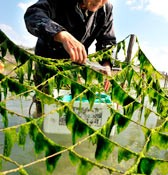
January 24, 2014 Ryukyu Shimpo
The arsa or hitoegusa (Monostroma nitidum Wittrock) seaweed harvest has started at Ojima, Nanjo City. Shigemasa Oshiro, 59, who visited a beach on the island, said, “This year’s cold and sunny weather helps arsa grow very well.”
The seaweed, which was planted last September, has grown enough to be harvested at the beginning of January. The arsa harvest happens three times each season.
The first harvested arsa has bright green color, and it will be sold fresh. Cooking fresh arsa with miso soup is very tasty. Arsa tsukudani and tempura sold in stores are popular with visitors.
(English translation by T&CT, Hitomi Shinzato)
Go to Japanese









 Webcam(Kokusai Street)
Webcam(Kokusai Street)


